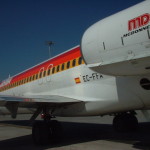Employee ‚Green Team‘ unveils new hybrid employee buses at Newark Liberty – Reduced greenhouse gas emissions per revenue passenger mile by 38 percent since 1997 – Focus on the environment has spanned more than a decade
HOUSTON – Continental Airlines (NYSE: CAL) recognizes the importance of protecting and preserving the environment: between 2006 and 2009, the airline collected more than 16.6 million pounds of recyclable materials from its hub airports and operated the first demonstration flight by a U.S. carrier using biofuel.
„At Continental, we take environmental responsibility seriously, and we have for more than ten years,“ said Leah Raney, Continental’s managing director of global environmental affairs. „Continental has comprehensive programs to reduce greenhouse gas emissions; promote recycling inflight and at its facilities; support alternative fuel development; construct facilities responsibly; and offer customers a thoughtful carbon offsetting option. We’re celebrating our accomplishments on Earth Day, but our commitment really extends to every day of the year, and to every facet of our operation.“
Reducing Greenhouse Gas Emissions
Continental flies the most fuel-efficient fleet of any major U.S. airline, and, since 1997, the airline has reduced greenhouse gas emissions and fuel consumption by 38 percent per revenue passenger mile. Every year since 1997, Continental has flown more people, more miles, to more locations. At the same time, the airline has reduced greenhouse gas emissions by four million metric tons by modernizing its fleet.
„The No. 1 way that an airline can substantively reduce its impact on the environment is by lowering greenhouse gas emissions from aircraft by reducing the amount of fuel we burn,“ Raney said.
Continental’s fuel efficiency improvements are due in large part to an investment of more than $13 billion during the past 12 years to acquire 300 fuel-efficient aircraft and related equipment. All Continental aircraft are twin-engine aircraft, which burn less fuel and emit less carbon dioxide (CO2) than comparable three- and four-engine aircraft.
In addition to flying fuel-efficient aircraft types, Continental has equipped its fleet with fuel-saving modifications to further reduce greenhouse gas emissions. For example, more than 97 percent of our narrowbody aircraft are equipped with winglets, which are wingtip extensions that lower aircraft drag and result in up to a five (5) percent reduction in emissions and noise. Continental has also installed advanced-technology GE90 3D Aero Blades – a more efficient fan blade – on its Boeing 777 engines, reducing emissions and fuel consumption on the airline’s longest-range aircraft.
Going forward, Continental has also committed to invest in additional new, fuel-efficient aircraft and ground equipment worth more than $10 billion, with even cleaner technology, through 2016. This includes Continental’s order for the Boeing 787 Dreamliner; Continental has placed one of the largest orders for this aircraft, with 25 scheduled for delivery.
By improving operational procedures, Continental has further reduced greenhouse gas emissions. The airline employs an enhanced flight-planning system to minimize fuel burn and will be implementing a new flight-planning system with next-generation technology. Where possible, aircraft are parked at the gate with air conditioning and electric power via alternative, energy-saving methods rather than using the aircraft’s own auxiliary power units. Continental uses ground equipment instead of aircraft engines to move aircraft from gate to gate whenever possible, and only one engine during ground taxi whenever possible.
Continental’s goal of reducing greenhouse gas emissions extends to its operations on the ground. The airline uses Low Emissions Vehicles and electric ground service equipment where possible, and through the use of such equipment has reduced by 75 percent nitrogen oxide emissions from ground equipment at Houston’s Bush Intercontinental Airport, Continental’s largest hub.
At the airline’s New York hub at Newark Liberty, employees have worked together to establish a local „Green Team,“ and during their third annual Earth Day event, this team is unveiling new hybrid employee buses, which will further reduce Continental’s greenhouse gas emissions.
„Our team of employee volunteers works hard to review our impact on the environment at Newark Liberty, and we thought that one of the best ways we could make a difference was to start using hybrid buses to transport workers from the parking lots to the terminals,“ said Newark Facilities Maintenance Director and „Green Team“ leader Nick Klym.
Recycling
„Continental has had a recycling program in place for many years, but in 2008 and 2009, we took steps to expand that program,“ Raney said. „We now recycle onboard our aircraft, at our airport terminals and at other supporting facilities, like our food service kitchens, and we’ve seen excellent results already – such as 6.1 million pounds of recyclables collected from our hub operations.“
Recyclables include newspapers, cans, cardboard, and plastic bottles contributed by co-workers and customers via designated „EcoSkies“ recycling bins in hub airport terminals and support facilities. Continental collected more than 16.6 million pounds of such items between 2006 and 2009.
Continental also works with contract caterers at the non-hub airports it serves to encourage recycling. Today, more than 91 percent of Continental’s domestic catering partners and more than 87 percent of its international caterers recycle.
Proceeds from Continental’s recycling program are reinvested in the program or donated to We Care, a nonprofit charity organization that provides financial assistance to Continental employees in need.
Looking at Alternative Fuels
Continental is committed to the development of alternative fuels as part of a national energy policy that will promote energy sources other than crude oil, freeing up crude oil for those solely dependent on it until technology evolves. Continental is working with industry partners to develop alternative jet fuels that are safe, economically viable and more environmentally friendly than today’s fuels and that can be available in reliable quantities.
To this end, in January 2009, Continental became the first U.S. carrier to perform a two-engine aircraft flight demonstration using sustainable biofuels. Continental partnered with Boeing, GE Aviation’s CFM International and Honeywell’s UOP to select algae and jatropha as biofuel sources for the demonstration flight because those sources don’t compete with food crops, deplete water resources or contribute to deforestation.
The biofuel blend performed as well as or better than traditional jet fuel, displaying an approximately 1.1 percent increase in fuel efficiency over traditional jet fuel. Overall life cycle greenhouse gas emissions related to a biofuel of the nature used on the Continental demonstration flight are estimated to be reduced by 60 to 80 percent as compared to traditional jet fuel.
No modifications to the aircraft or engine were necessary to use this „drop-in“ fuel.
„We are very encouraged by the results of our biofuel demonstration flight,“ Raney said. „Demonstration flights of this nature have shown that alternative fuels are capable of performing well in aircraft, so now the next step is certification for commercial use. Results from Continental’s flight will help in that process.“
Customers Can Get Involved
„We recognize that many of our customers and our employees are looking for ways that they can reduce their impact on the environment while traveling on Continental, so we have identified several ways that we can help them do that,“ Raney said.
Continental offers customers the opportunity to recycle newspapers used onboard, and flight attendants also separate items to recycle from its beverage and meal service, such as aluminum cans and plastic meal trays. In addition, Continental has put into place recycling bins in terminals.
„One way that customers can help is to make sure to use the recycling bins for their designated purpose,“ Raney said. „Keeping trash out of the recycling bins ensures that the cans and bottles that can be recycled, will be recycled.“
Continental also partners with Sustainable Travel International to offer customers an opportunity to offset the environmental impact of their travel. Customers can select and contribute to high-impact projects designed to reduce greenhouse gases, such as reforestation or renewable energy. Sustainable Travel International provides carbon offset projects located in the U.S. and around the world that are independently verified or certified by third-party sources.
In addition to the passenger carbon offset program, Continental launched North America’s first airline cargo emissions calculator. This innovative tool allows cargo shippers to determine the greenhouse gas impact of their shipments and provides an option for them to contribute to carbon offsets.
About Continental
Continental Airlines is the world’s fifth largest airline. Continental, together with Continental Express and Continental Connection, has more than 2,700 daily departures throughout the Americas, Europe and Asia, serving 132 domestic and 137 international destinations. Continental is a member of Star Alliance, which overall offers 19,700 daily flights to 1,077 airports in 175 countries through its 26 member airlines. With more than 40,000 employees, Continental has hubs serving New York, Houston, Cleveland and Guam, and, together with its regional partners, carries approximately 63 million passengers per year.
Continental consistently earns awards and critical acclaim for both its operation and its corporate culture. For nine consecutive years, FORTUNE magazine has ranked Continental as the top U.S. airline on its „World’s Most Admired Companies“ airline industry list. For more company information, go to continental.com.





